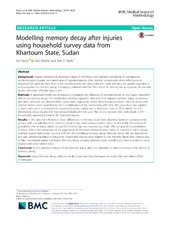| dc.contributor.author | Heuch, Ivar | |
| dc.contributor.author | Abdalla, Safa | |
| dc.contributor.author | El Tayeb, Sally | |
| dc.date.accessioned | 2018-08-24T08:42:27Z | |
| dc.date.available | 2018-08-24T08:42:27Z | |
| dc.date.issued | 2018-06-20 | |
| dc.Published | Heuch I, Abdalla S, El Tayeb S. Modelling memory decay after injuries using household survey data from Khartoum State, Sudan. BMC Medical Research Methodology. 2018;18:58 | eng |
| dc.identifier.issn | 1471-2288 | en_US |
| dc.identifier.uri | https://hdl.handle.net/1956/18221 | |
| dc.description.abstract | Background: Injuries represent an important cause of morbidity and mortality worldwide. In retrospective epidemiological studies, estimated rates of reported injuries often decline considerably when information is included from periods more than a few months before the data collection. Such low rates are usually regarded as a consequence of memory decay. It is largely unknown whether the extent of memory decay depends on external factors otherwise affecting injury rates. Methods: A statistical model was introduced to separate the influence of external factors on true injury rates from effects on memory decay. The relationship between apparent rates and time elapsed between injury occurrence and data collection was described by a parametric regression model. Relationships between memory decay and external factors were modelled by effect modification of the relationship with time. The procedure was applied to data collected in a retrospective household survey, carried out in Khartoum State in 2010, which elicited information about injuries that had occurred during the last year. The survey included 5661 individuals in 973 households, reporting a total of 481 non-fatal injuries. Results: In the data from Khartoum State, differences in memory recall were observed between socioeconomic groups, with considerably faster memory decay in the lower socioeconomic tertile. In this tertile the estimated probability that an injury which occurred 6 months ago was reported was only 18%, compared to probabilities of about 35% in the remainder of the population. In the lower socioeconomic tertile, in contrast to other groups, a simple exponential model was not sufficient for describing memory decay. Memory decay did not depend on sex, age, urban/rural status or education. Road traffic injuries were subject to less memory decay than injuries due to falls, mechanical causes and burns. Memory decay seriously affected crude overall injury rates and also to some degree estimated relative rates. Conclusion: In the statistical analysis of retrospective injury data it is important to take into account the effects of memory decay. | en_US |
| dc.language.iso | eng | eng |
| dc.publisher | BioMed Central | en_US |
| dc.rights | Attribution CC BY | eng |
| dc.rights.uri | http://creativecommons.org/licenses/by/4.0 | eng |
| dc.subject | Injury | eng |
| dc.subject | Memory decay | eng |
| dc.subject | Memory recall | eng |
| dc.subject | Underreporting | eng |
| dc.subject | Retrospective study | eng |
| dc.subject | Rate estimation | eng |
| dc.subject | Effect modification | eng |
| dc.title | Modelling memory decay after injuries using household survey data from Khartoum State, Sudan | en_US |
| dc.type | Peer reviewed | |
| dc.type | Journal article | |
| dc.date.updated | 2018-06-21T18:33:26Z | |
| dc.description.version | publishedVersion | en_US |
| dc.rights.holder | Copyright 2018 The Author(s) | en_US |
| dc.identifier.doi | https://doi.org/10.1186/s12874-018-0523-9 | |
| dc.identifier.cristin | 1593038 | |
| dc.source.journal | BMC Medical Research Methodology | |

